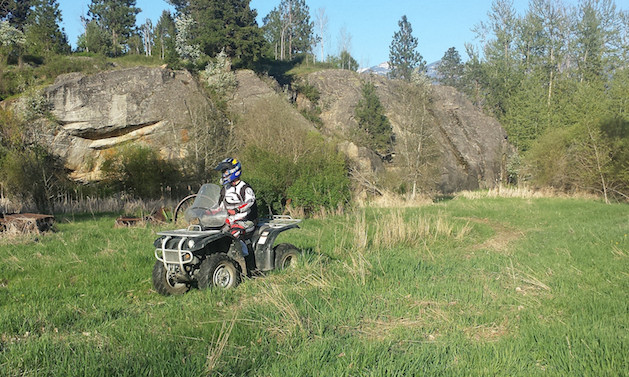According to the warning labels on ATVs, riding if you’re under 16 pretty much equals a certainty of serious injury or death; ditto for carrying a passenger (on machines designed to carry one rider). Not only that, but the National Institutes of Health considers children and passengers at especially high risk of injury while riding ATVs. Yet a large segment of ATV riders are under 16, and many riders carry passengers (even passengers who are children). Is that safe?
Regulations vary by province and can be a bit foggy at times. British Columbia, for example, provides a Q & A for its new ORV Act that states, in reference to operating ORVs—off-road vehicles—on Crown land: “Children, under 16 years, must meet the manufacturer’s minimum age for the specific vehicle they wish to operate.” The Q & A further says, “Along with the manufacturer’s recommendation for minimum age to operate an ORV, the approach is to leave it up to a parent or guardian to determine the minimum age of their child (to operate an off-road vehicle).”
ATV clubs worldwide work hard to promote safe riding. Kim Robicheau, office administrator of the Alberta Off-Highway Vehicle Association (AOHVA), said, “An ATV built for one rider should have only one rider—a passenger can limit the driver's ability to properly control their machine (affect turning, stopping, etc.) and a passenger will make the ATV unbalanced." It will come as no surprise that AOHVA’s guiding principles address the topic of young riders as well: “Safe operation of age-appropriate off highway vehicles, wearing proper safety gear (including helmets) and riding on designated trails only.”
Bottom line—safety is often a matter of common sense.
Looking at two of the biggest contributors to ATV injuries—passengers and young riders—it seems obvious that these are factors well within our control.
Passengers
First consider passengers. With the exception of machines designed to carry two or more people, ATVs generally aren’t meant to carry passengers. But what about all those aftermarket seat kits and rear pegs you see? You’ll notice that their marketing usually doesn’t include the word passenger. This is because one-person ATVs have a short wheelbase and a weight limit that allows for the body weight of a typical adult rider. Even though some rear racks are rated for 150 or so pounds, the weight on a rack tends to be distributed lower than the weight of a seated passenger is. Doubling the rider weight by adding a passenger moves the centre of gravity up and to the rear of the machine, and that, combined with the short wheelbase, dramatically increases the likelihood of a rollover, especially during cornering or on uneven terrain. It’s physics, pure and simple—if your ATV isn’t designed to ride two-up, don’t ride two-up.
The common-sense exception here would be riding at extremely low speed on perfectly flat terrain. Long-time quadding enthusiast Carol Dickson is especially mindful of the effects of the shorter wheelbase. “I haven’t had any bad incidents,” she said. “But when you’re riding two-up, slow down, especially around corners.”
Young riders
Now consider young riders. Though there undoubtedly exist some children who possess “the knowledge, physical size and strength, and cognitive and motor skills to operate (ATVs) safely,” it’s equally certain that most children do not. They just haven’t been here long enough to gain those qualities that only experience can provide. So, is it safe to suit up a 10-year-old in all kinds of safety gear and give him/her the go-ahead to let ’er rip over hilly terrain on a powerful machine that weighs 400-plus pounds and could easily flip or roll on its young rider? Hopefully most people will agree that the only answer common sense suggests is a resounding no.
There is a common-sense exception, though: There are small, light, less powerful ATVs available that are meant for young riders—with adequate supervision, of course.
Safety doesn’t have to take away from the enjoyment of your ride. And it’s up to you to make smart riding choices, wear appropriate safety gear and use your common sense. That way you can have fun for many more rides to come.
What to know about riding on Crown land
Before riding on Crown land or forest service roads, it’s a good idea to check provincial or state safety laws as well as legislation regarding registration, licensing and insurance. Click to see off-road vehicle laws in British Columbia, Alberta, or Saskatchewan.








Comments